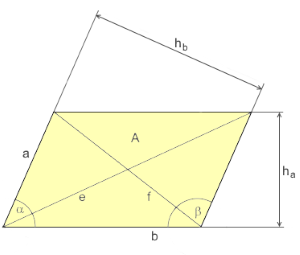Calculate parallelogram
Calculator and formulas for the rhomboid with parallel sides
Parallelogram calculator
The parallelogram (rhomboid)
A parallelogram has two pairs of parallel sides with opposite equal angles.
Parallelogram structure
Parallelogram properties
Remark: Opposite sides are parallel and equal, α + β = 180°
The parallelogram with parallel sides a∥c and b∥d.
Opposite angles are equal: α = γ, β = δ.

|
|
The parallelogram: elegance of parallel lines
The parallelogram (rhomboid) is a fundamental geometric quadrilateral:
- Parallel sides: a ∥ c and b ∥ d (two side pairs)
- Equal lengths: |a| = |c| and |b| = |d|
- Supplementary angles: α + β = 180° (adjacent angles)
- Equal opposite angles: α = γ and β = δ
- Diagonals bisect each other: Intersection is the center
- Height relation: A = a · hb = b · ha
Geometric properties of the parallelogram
The special properties of the parallelogram make it very versatile:
Parallelism and symmetry
- Two pairs of parallel sides
- Point-symmetric with respect to the diagonal intersection
- Opposite sides have equal length
- No mirror symmetry (except rectangle/rhombus)
Angle properties
- Opposite angles are equal
- Adjacent angles are supplementary (180°)
- Angle sum: α + β + γ + δ = 360°
- Only two distinct angle measures
Mathematical calculations in the parallelogram
Calculation methods for parallelograms are varied and elegant:
Area calculations
- A = a · h_b = b · h_a (base × height)
- A = a · b · sin(α) (sides × sine)
- Heights: h_a = b · sin(α), h_b = a · sin(α)
- Three equivalent calculation methods
Diagonal calculations
- Law of cosines for both diagonals
- e = √(a² + b² - 2ab·cos(β))
- f = √(a² + b² - 2ab·cos(α))
- Diagonals bisect each other
Applications of the parallelogram
Parallelograms have many practical applications:
Architecture & construction
- Roof constructions using parallelogram shapes
- Truss structures and bracing
- Skewed window and door frames
- Modern building geometries
Engineering & mechanical design
- Gear and transmission linkages
- Parallelogram linkages in mechanisms
- Pantograph systems (current collectors)
- Windshield wiper mechanisms
Design & art
- Graphic design and layout composition
- Typography (italic fonts)
- Logo design with dynamic shapes
- Architectural visualization
Physics & mathematics
- Force parallelogram in mechanics
- Vector addition and decomposition
- Coordinate transformations
- Crystallography (lattice structures)
Formulas for the parallelogram
Area A
Three equivalent calculation methods
Perimeter P
Double sum of adjacent sides
Heights h_a and h_b
Heights from area or trigonometry
Diagonals e and f
Law of cosines for both diagonals
Side lengths from area
Back-calculation of sides
Angle α from area
Compute angle from given area
Angle relations
Supplementary adjacent angles, equal opposite angles
Worked example for a parallelogram
Given
Find: All parameters of the parallelogram
1. Area and perimeter
Area with sine formula, perimeter as side sum
2. Compute heights
Heights via trigonometric relation
3. Angles and diagonals
Supplementary angle β and diagonals via law of cosines
4. Complete parallelogram
The complete parallelogram - elegant parallelism in practice!
The parallelogram: elegance of parallelism in geometry and engineering
The parallelogram stands as a fundamental geometric form expressing the principle of parallelism. With two pairs of parallel sides and the characteristic property that opposite sides and angles are equal, it embodies geometric harmony and has many applications from mechanics to modern architecture.
The beauty of parallel geometry
The parallelogram fascinates through its elegant properties:
- Double parallelism: Two side pairs a∥c and b∥d create a stable structure
- Symmetry of opposites: Opposite sides and angles are equal
- Supplementary harmony: Adjacent angles sum to 180°
- Central symmetry: Point-symmetric about the diagonal intersection
- Triple area formula: A = a·hb = b·ha = a·b·sin(α)
- Diagonal bisection: Both diagonals bisect each other
Parallelograms in nature and technology
Nature and human technology use parallelogram structures for stability and function:
Mechanical systems
Parallelogram linkages in vehicle technology ensure uniform movement. Pantographs on trains use this geometry for consistent contact with overhead lines.
Crystal structures
Many minerals form parallelogram-like lattice structures. This arrangement minimizes energy and maximizes structural stability.
Architecture and construction
Modern architecture uses parallelogram forms for dynamic building silhouettes. Truss constructions use this geometry for optimal load distribution.
Physics and forces
The force parallelogram is fundamental in mechanics. Vector addition and decomposition are based on parallelogram principles.
Mathematical elegance and calculation variety
The parallelogram offers remarkable mathematical flexibility:
- Three area formulas: base×height, sides×sine, height-dependent variants
- Trigonometric relations: Heights as h_a = b·sin(α), h_b = a·sin(α)
- Law of cosines for diagonals: Both diagonals via a unified formula
- Angle arithmetic: α + β = 180°, only two independent angles
- Invertibility: All parameters computable from various inputs
- Special cases: Rectangle (α = 90°) and rhombus (a = b) as special forms
Modern applications and future perspectives
The parallelogram gains new relevance in the digital era:
Computer Graphics
Parallelograms are building blocks for texture mapping and 3D transformations. Affine transforms preserve parallelism.
Robotics and automation
Parallelogram mechanisms in industrial robots provide precise, repeatable motion. Delta robots use this geometry for high-speed operations.
Architectural innovation
Parametric architecture uses parallelogram variations for adaptive facades. Smart buildings use this geometry for movable shading systems.
Material science
Metamaterials with parallelogram structures show special mechanical properties. Negative Poisson ratios emerge from clever parallelogram arrangements.
Parallelograms as a design principle
The parallelogram inspires modern design through its dynamic statics:
- Visual Dynamics: Oblique angles create the illusion of movement in static objects
- Typographic Design: Italic fonts are based on parallelogram principles
- Logo Design: Parallelograms convey progress and dynamism
- UI/UX Design: Oblique interface elements create modern aesthetics
- Industrial Design: Parallelogram shapes suggest speed and efficiency
- Architectural Identity: Parallelogram buildings become striking landmarks
|
|
|
|